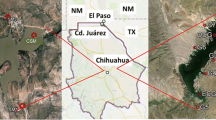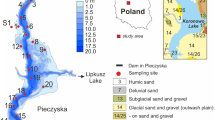Abstract
Purpose
The sediments accumulated in the Yesa Reservoir (Central Spanish Pyrenees) have greatly decreased its water storage capacity and are a major threat to the sustainability of water resources in the region. This study examines the contents of radionuclides and stable elements in the reservoir sediments and relates their variations with the sediment composition and local sedimentary dynamics, particularly flood frequency and intensity, which are responsible for changes in the main supply and distribution of radionuclides in the basin.
Materials and methods
The sedimentary sequence accumulated in the Yesa Reservoir (471 Hm3), which supplies water to ca. 1,000,000 people and for irrigation, was examined in two 4-m long sediment cores (Y1, Y2) and one profile (Y3) retrieved at its central part. In the sediments, radionuclide activities of 238U, 226Ra, 232Th, 40K, 210Pb and 137Cs were measured using a hyperpure Ge coaxial detector. The stable elements Mg, Ca, Sr, Ba, Cr, Cu, Mn, Fe, Al, Zn, Ni, Co, Pb, Li, K and Na were analysed by ICP-OES. Complementary analyses to characterize the sediments included: XRD in the profile, grain size distribution by laser equipment and the contents of organic matter, carbonates and the residual fraction by loss on ignition.
Results and discussion
The variation in radionuclide activities is associated with grain size and sediment composition. The activity levels (becquerels per kilogram) ranged between 20 and 43 for 238U, 14 and 40 for 226Ra, 7 and 56 for 210Pb, 19 and 46 for Th232, 1 and 48 for 137Cs and 185 and 610 for 40K. Enriched activity levels are associated with clayey and silty layers, and depleted levels with sandy layers. The levels of radionuclides and trace elements were significantly lower in the cores than in the profile because of its higher silicate content and the influence of inflow of spring mineral-rich waters. The correlations among radionuclides, sediment components and stable elements provided evidence of a stronger influence of the dynamics of sediment supply by floods in the central areas closer to the main channel (cores) than in the littoral areas (profile).
Conclusions
The radionuclide distributions were consistent with the history of the reservoir infilling and with the processes of transport and accumulation of sediments. Compared to the natural radionuclides, the artificial radionuclide 137Cs varied the most and showed distinctive patterns. The methods used allowed the identification of natural inputs into the system and its differentiation from fluvial transport and reservoir deposition. The results provide insights into the pathways and processes involved in the mobilization of radionuclides in the environment.






Similar content being viewed by others
References
Bacon MP, Spencer DW, Brewer PG (1976) 210 Pb/226 Ra and 210 Po/210 Pb disequilibria in seawater and suspended particulate matter. Earth Planet Sci Lett 32:277–296
Baeza A, Guillén J, Ontalba Salamanca MA, Rodrıíguez A, Ager FJ (2009) Radiological and multi-element analysis of sediments from the Proserpina reservoir (Spain) dating from Roman times. J Environ Radioactiv 100:866–874
Benninger LK, Lewis DM, Turekian KK (1975) On the use of natural Pb-210 as a heavy metal tracer in the river-estuarine system. In: Church TM (ed) Marine chemistry in the coastal environment. American Chemical Society, Washington DC, ACS Symposium Series; chapter 12, vol. 18, pp 202–210
Callender E, Robbins JA (1993) Transport and accumulation of radionuclides and stable elements in a Missouri River Reservoir. Water Resour Res 29:1787–1804
Chi-Ju L, Yu-Chia C, Tsung-En W (2004) Ra-226 and Pb-210/Ra-226 activity ratio in the Northern South China Sea. In: American Geophysical Union, Spring Meeting 2004, abstract #OS41A-0
de Jong E, Acton DF, Kozak LM (1994) Naturally occurring gamma-emitting isotopes, radon release and properties of parent materials of Saskatchewan soils. Can J Soil Sci 74:47–53
Dowdall M, O'Dea J (2002) Ra-226/U-238 disequilibrium in an upland organic soil exhibiting elevated natural radioactivity. J Environ Radioactiv 59:91–104
Evans CV, Morton LS, Harbottle G (1997) Pedologic assessment of radionuclide distributions: use of a radio-pedogenic index. Soil Sci Soc Am J 61:1440–1449
Faure G (1986) Principles of isotope geology, 2nd edn. Wiley, New York
Fleischer RL (1983) Theory of alpha recoil effects on radon release and isotopic disequilibrium. Geochim Cosmochim Acta 47:779–784
Foster IDL (2006) Lakes and reservoirs in the sediment delivery system: reconstructing sediment yields. In: Owens PN, Collins AJ (eds) Soil erosion and sediment redistribution in river catchments. CAB International, Wallingford, pp 128–142
Foster IDL, Boardman J, Keay-Bright J (2007) Sediment tracing and environmental history for two small catchments, Karoo Uplands, South Africa. Geomorphology 90:126–143
Fujiyoshi R, Sawamura S (2004) Mesoscale variability of vertical profiles of environmental radionuclides (40K, 226Ra, 210Pb and 137Cs) in temperate forest soils in Germany. Sci Total Environ 320:177–188
Ivanovich M (1994) Uranium series disequilibrium: concepts and applications. Radiochim Acta 64:81–94
Jasinska M, Niewiadomski T, Schwbenthan J (1982) Correlation between soil parameters and natural radioactivity. In: Vohra K, Mishra UC, Pillai KC, Sadasivan S (eds) Natural radiation environment. Wiley, New York, pp 206–211
Jordan C, Cruickshank JG, Higgins AJ, Hamill KP (1997) The soil geochemical atlas of Northern Ireland. Department of Agriculture for Northern Ireland, Belfast
Kabata-Pendias A, Pendias H (2001) Trace elements in soils and plants, 3rd edn. CRC, Boca Raton, p. 413
Krishnaswami S, Somayajulu BLK, Chung Y (1975) 210Pb/226Ra disequilibrium in the Santa Barbara basin. Earth Planet Sci Lett 27:388–392
Litaor MI (1995) Uranium isotopes distribution in soils at the Rocky Flats Plant, Colorado. J Environ Qual 24:314–323
Lorente A, García-Ruíz JM, Beguería S, Arnaez JM (2002) Factors explaining the spatial distribution of hillslope debris flows. A case study in the Flysch Sector of the Central Spanish Pyrenees. Mt Res Dev 22:32–39
MacKenzie AB (2000) Environmental radioactivity: experience from the 20th century—trends and issues for the 21st century. Sci Total Environ 249:313–329
McCall PL, Robbins JA, Matisoff G (1984) 137Cs and 210Pb transport and geochronologies in urbanized reservoirs with rapidly increasing sedimentation rates. Chem Geol 44:33–65
McLean RI, Summers JK, Olsen CR, Domotor SL, Larsen IL, Wilson H (1991) Sediment accumulation rates in Conowingo reservoir as determined by man-made and natural radionuclides. Estuaries 14:148–156
Megumi K, Oka T, Yaskawa K, Sakanoue M (1982) Contents of natural radioactive nuclides in relation to their surface area. J Geophys Res 87:10857–10860
Mercer TT (1976) The effect of particle size on the escape of recoiling RaB atoms from particulate surfaces. Health Phys 31:173–175
Morellón M, Valero Garcés B, Moreno A, González Sampériz P, Mata P, Romero O, Maestro M, Navas A (2008) Holocene Paleohydrology and climate variability in Northeastern Spain: The sedimentary record of Lake Estanya (Pre-Pyrenean Range). Quatern Int 118:15–31
Navas A, Machín J (2002) Spatial distribution of heavy metals and arsenic in soils of Aragón (NE Spain): controlling factors and environmental implications. Appl Geochem 17:961–973
Navas A, García-Ruiz JM, Machín J, Lasanta T, Walling D, Quine T, Valero B (1997) Aspects of soil erosion in dry farming land in two changing environments of the central Ebro valley, Spain. In: Walling DE, Probst JL (eds) Human impact on erosion and sedimentation. IAHS, Wallingford, 245:13–20
Navas A, Valero-Garcés BL, Machín J (2004) An approach to integrated assessment of reservoir siltation: the Joaquín Costa reservoir as case study. Hydrol Earth Syst Sci 8:1193–1199
Navas A, Machín J, Soto J (2005a) Assessing soil erosion in a Pyrenean mountain catchment using GIS and fallout 137 Cs. Agr Ecosyst Environ 105:493–506
Navas A, Soto J, Machín J (2005b) Mobility of natural radionuclides and selected major and trace elements along a soil toposequence in the central Spanish Pyrenees. Soil Sci 170:743–757
Navas A, Valero-Garcés B, Gaspar L, García-Ruiz JM, Beguería S, Machín J, López-Vicente M (2008) Variabilidad espacial del transporte de sedimento en la cuenca superior del rio Aragón. Cuadernos de Investigación Geográfica 34:39–60
Navas A, Valero-Garcés BL, Gaspar L, Machín J (2009) Reconstructing the history of sediment accumulation in the Yesa reservoir: an approach for management of mountain reservoirs. Lake Reserv Manage 25:15–27
Navas A, Gaspar L, López-Vicente M, Machín J (2011) Spatial distribution of natural and artificial radionuclides at the catchment scale (South Central Pyrenees). Radiat Meas 46:261–269
Norrisk K (1975) The geochemistry and mineralogy of trace elements. In: Nicholas DJD, Egan AR (eds) Trace elements in soil plant-animal systems. Academic, New York, p 55
Rank D, Kralik M, Gyurits KA, Maringer F, Rajner V, Kurcz I (1987) Investigation of sediment transport in the Austrian part of the Danube using environmental isotopes. IAEA-SM 299:637–646
Schultz LG (1964) Quantitative interpretation of mineralogical composition from X-ray and chemical data of the Pierre Shale. US Geol Surv Prof Paper. 391C
Simms AD, Woodroffe C, Jones BG, Heijnis H, Mann RA, Harrison J (2008) Use of 210Pb and 137Cs to simultaneously constrain ages and sources of post-dam sediments in the Cordeaux reservoir, Sydney, Australia. J Environ Radioactiv 99:1111–1120
Sundborg A, Rapp A (1986) Erosion and sedimentation by water: problems and prospects. Ambio 15:215–225
Valero-Garcés BL, Navas A, Machín J, Walling D (1999) Sediment sources and siltation in mountain reservoirs: a case study from the Central Spanish Pyrenees. Geomorphology 28:23–41
Valero-Garcés B, Moreno A, Navas A, Mata P, Machín J, Delgado-Huertas A, González-Sampériz P, Schwalb A, Morellón M, Edwards L (2008) The Taravilla lake and Tufa deposits (Central Iberian Range, Spain) as paleohydrological and paleoclimatic indicators. Paleogeogr Palaeocl 259:136–156
Vanden Bygaart AJ, Protz R (1995) Gamma radioactivity on a chronosequence, Pinery Provincial Park, Ontario. Can J Soil Sci 75:73–84
Villar L, Sesé JA, Fernández JV (2001) Atlas de la Flora del Pirineo aragonés. II, Instituto de Estudios Altoaragoneses y Consejo de Protección de la Naturaleza de Aragón, Huesca y Zaragoza, p 790
Walling DE, Owens PN, Foster IDL, Lees JA (2003) Changes in the sediment dynamics of the Ouse and Tweed basins in the UK, over the last 100–150 years. Hydrol Processes 17:3245–3269
Zhang X, Walling DE, Yang Q, He X, Wen Z, Qi Y, Feng M (2006) 137Cs budget during the period of 1960s in a small drainage basin on the Loess Plateau of China. J Environ Radioactiv 86:78–91
Acknowledgements
Financial support from the CICYT project MEDEROCAR (CGL2008-00831/BTE) is gratefully acknowledged.
Author information
Authors and Affiliations
Corresponding author
Additional information
Responsible editor: Ian Foster
Rights and permissions
About this article
Cite this article
Navas, A., Valero-Garcés, B., Gaspar, L. et al. Radionuclides and stable elements in the sediments of the Yesa Reservoir, Central Spanish Pyrenees. J Soils Sediments 11, 1082–1098 (2011). https://doi.org/10.1007/s11368-011-0401-0
Received:
Accepted:
Published:
Issue Date:
DOI: https://doi.org/10.1007/s11368-011-0401-0




